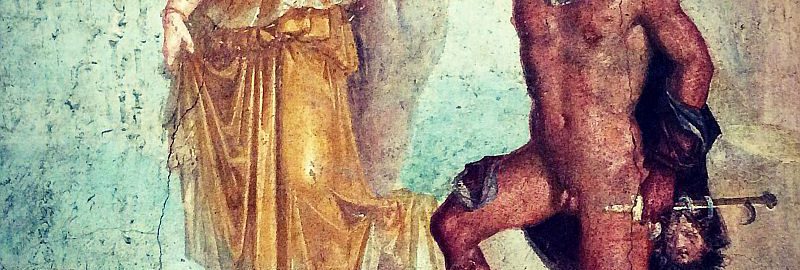A beautiful Pompeian fresco depicting the Greek hero – Perseus, releasing Andromeda. According to mythology, Perseus returns from the expedition against the monster Gorgon – Medusa (as you can see on the fresco – a successful expedition. Perseus holds Medusa’s severed head in his hand), he met Andromeda chained to the rock.
Here, the myth of Perseus merges with another, in which princess Andromeda was sacrificed by her people, who, offering her to be devoured by another monster – Cetus, wanted to free themselves from him. When he met the imprisoned Andromeda, Perseus freed her and took her as wife. When you take a good look, you’ll see the toothed mouth of Cetos in the lower left corner.
The fresco is extremely beautiful – Perseus is not depicted on it at the time of his greatest victory, that is, after defeating Medusa, but when he meets a woman who will become his wife. So this is not a heroic scene illustrating the heroic deeds of Perseus. On the contrary – it is calm, calm and full of intimate charm. Andromeda is partially exposed – Perseus does not look directly at her, but as if embarrassed by her protruding naked breast, he looks down.
According to the painting convention, the body of Perseus is darker, and Andromeda – lighter. This is the usual gender difference in Greek-Roman painting. Perseus is naked, only his back is covered with a coat. Of course, this is just an artistic convention – so-called “heroic nudity” in art was reserved for gods, heroes, athletes, warriors, and over time also for chiefs (Roman emperors were sometimes just presented naked to emphasize their divinity or heroism). The background is barely outlined and expressed rather symbolically through rocks and stones. – it is also an element of the painting convention, according to which the viewer’s entire attention was to focus on the characters. Pay attention to the thoughtful arrangement of the characters that fit into the rhombus.
The fresco is a copy of a Greek table painting, probably painted by the Athenian painter Nikias who created in the 4th century BCE. This copy was made on the wall of a Pompeian house called the “House of the Dioscuri” and is probably authored by some local craftsman of that time (yes yes! Fresco painters were not considered artists in Rome, but craftsmen!). There were many similar frescoes on the same subject and almost identical layout in Pompeii, several have survived to our times. But no copy of the work of Nikias matches the fresco from the House of Castor and Pollux.
I am fascinated by how beautiful the original easel painting must have been, since even a copy of it was made by a provincial painter in a secondary Roman town, it still impresses us after almost two millennia.







